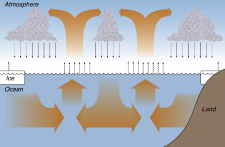|
Why Should We Worry About an "Intensified" Water Cycle?
The water cycle is a very large and mainly oceanic process, so terrestrial records cannot tell us much about the
global picture. In addition, the oceanic water cycle is untouched by man, and since that is where most of the
action is, it makes sense that the ocean is where we need to look for change in the water cycle. Salinity is a great
integrator of the water cycle over the ocean and it tells us what changes are afoot.An intensified water cycle means drier in some places and wetter in others and, in the oceans, the salty regions getting saltier and the fresh regions getting fresher. The rate of intensification appears to be stronger than any of the models have predicted. The main questions are how much and how fast these changes will occur. Featured Video: An Intensification of Extremes
An Oceanographer And The Water Cycle [NASA Earth Observatory] If one wants to find out what the water cycle is doing, one should be looking at the oceans
Interactive Data Tools for Changes in Salinity Over Time [NASA Aquarius] Annual cycle maps and time-series plots for salinity, temperature, and density
Ocean Salinity Trends Show Human Fingerprint [Scripps Institution of Oceaongraphy] Like ocean temperature, variations in the last half-century are only explicable in the context of human-caused climate change Big Changes in Ocean Salinity Intensifying Water Cycle [Mother Jones]
Rapidly changing ocean salinities as a result of a warming atmosphere have intensified the global water cycle by an incredible four percent between 1950 and 2000 Dry Lands Getting Drier, Wet Getting Wetter... Science Daily
A clear change in salinity has been detected in the world's oceans, signalling shifts and an acceleration in the global rainfall and evaporation cycle Earth's Water Cycle Is Intensifying, Dry Is Getting Drier and Wet Is Getting Wetter [Planetsave]
The Earth's water cycle is intensifying, leading to more evaporation in dry climates and more rain in wet climates Aquarius Water Cycle [NASA]
Aquarius uses advanced technologies to give NASA its first space-based measurements of sea surface salinity, helping scientists to improve predictions of future climate trends and events Water, Water Everywhere: Water Cycle & Climate Change [NASA Aquarius]
The water cycle affects and is affected by climate variations What is Aquarius Data Telling Us? [COSEE-Ocean Systems]
Now that measurements of global salinity are being regularly collected by Aquarius, what type of phenomena have been observed with the data? What Does Sea Surface Salinity Tell Us About the Global Water Cycle? [COSEE-Ocean Systems]
NASA scientists work collaboratively with educators to examine connections between the water cycle, ocean circulation, climate, and sea surface salinity The Water Cycle - Water Science for Schools [USGS]
Earth's water is always in movement, and the natural water cycle describes the continuous movement of water on, above, and below the surface of the Earth |




